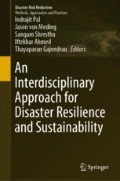Abstract
Cottage and small industries (CSIs) play a key role in poverty reduction in developing countries by creating opportunities for self-employment and income generation. CSIs in Nepal are faced with tremendous challenges mainly arising from poor access to credit, limited market, traditional management practices, and less efficient technology. These challenges combined with the broad economic, social, and political challenges of the country make the CSIs highly vulnerable. During the 2015 Nepal earthquake, Kathmandu district suffered the highest damages and losses in industry and commerce sector. With many challenges already present to cope with, preparedness for earthquake was hardly one of the priority areas for the CSIs. The 2015 Nepal earthquake was a major earthquake to struck Nepal since 1934, and Kathmandu valley is less prone to flood and landslide hazards that are frequent in other parts of the country. However, business enterprises in Nepal face frequent business disruptions caused by political unrest. Cottage and small enterprises may have certain coping mechanism to minimize the indirect impacts of frequent business disruptions, which may have been helpful in coping with the earthquake impacts. The primary objective of this paper is to synthesize lessons for improving resilience of manufacturing cottage and small enterprises in Kathmandu district by identifying preparedness activities for earthquake and man-made hazards and assessing their helpfulness in coping with the 2015 earthquake impacts. The results show that informal social capital and maintenance of emergency fund helped the enterprises in acquiring funds for recovery, while formal/organizational social capital, comprehensive preparedness planning (e.g., BCP), and earthquake risk mitigation measures improved their resilience.
Access this chapter
Tax calculation will be finalised at checkout
Purchases are for personal use only
References
ADPC, UNESCAP, R3ADY Asia-Pacific (2015) Resilient business for resilient nations. Retrieved 4 Mar 2017 from https://www.adpc.net/igo/category/ID951/doc/2015-kpf6Jv-ADPC-Resilient.Business.FRNC.pdf
Alternative Energy Promotion Center (AEPC) (2014) Identification and documentation of micro, small and medium scale enterprises using solid biomass intensive combustion technologies for cooking, heating and thermal processes. Lalitpur, Nepal. Retrieved 22 Feb 2017 from http://aepc.gov.np
Asgary A, Anjum MI, Azimi N (2012) Disaster recovery and business continuity after the 2010 flood in Pakistan: case of small businesses. Int J Disaster Risk Reduction 2:46–56
Asian Development Bank (2016) Nepal: economy. Retrieved 27 Jan 2017, from https://www.adb.org/countries/nepal/economy
Birkmann J, Buckle P, Jaeger J, Pelling M, Setiadi N, Garschagen M, Kropp J (2010) Extreme events and disasters: a window of opportunity for change? Analysis of organizational, institutional and political changes, formal and informal responses after mega-disasters. Nat Hazards 55(3):637–655
Central Bureau of Statistics-Nepal (2014) Development of manufacturing industries in Nepal—current state and future challenges. Retrieved 22 Mar 2017 from http://cbs.gov.np/sectoral_statistics/manufacturing/development_manufacturing%20Industries_nepal_2014
CFE-DM (2015) Nepal disaster management reference handbook. Retrieved on 25 Feb 2017 from https://reliefweb.int/report/nepal/nepal-disaster-management-reference-handbook-2015
Dahlhamer JM, Tierney KJ (1998) Rebounding from disruptive events: business recovery following the Northridge earthquake. Sociol Spectr 18(2):121–141
De Mel S, McKenzie D, Woodruff C (2012) Enterprise recovery following natural disasters. Econ J 122(559):64–91
Department of Cottage and Small Industry (2016) Industrial development statistics. Kathmandu, Nepal
Department of Industry (2016) Industrial information system. Retrieved 15 Aug 2017 from http://www.doind.gov.np/index.php/notice/172-industrial-information-system
EEC, DFSME, LCCI, FNCSIN (2008) An analysis of selected sub-sectors of Nepal: (coffee, cut-flower and handmade Nepali paper). Kathmandu, Nepal. Retrieved 24 Feb from http://www.eec-nepal.org.np/eec/ecibon/report/211/Publication/
EEC, DFSME, LCCI & FNCSIN (2008) An analysis of selected sub-sectors of Nepal: (Coffee, cut-flower and handmade Nepali paper). Kathmandu, Nepal. Retrieved 5 Mar 2017 from http://www.eec-nepal.org.np/eec/ecibon/report/211/Publication/
Ghimire R (2011) Micro and small enterprises in Nepal: prospects and challenges. Retrieved 19 Oct 2017 from https://papers.ssrn.com/sol3/papers.cfm?abstract_id=2376078
Guha-Sapir D, Vos F (2011) Earthquakes, an epidemiological perspective on patterns and trends. In: Human casualties in earthquakes. Springer, Netherlands, pp 13–24
IFRC (2011) Analysis of legislation related to disaster risk reduction in Nepal. Geneva, Switzerland
International Labor Office (ILO) (2003) A report on micro and small enterprise policy review in Nepal. ILO Office, Nepal
Ministry of Finance-Nepal (2016) Economic survey-fiscal year 2015/2016. Kathmandu, Nepal
Ministry of Law, Justice and Parliamentary Affairs (MoLJPA) (2016) Industrial enterprise act 2073. Kathmandu, Nepal
National Planning Commission (NPC) (2015) Post disaster needs assessment, vol B. Kathmandu, Nepal
Nepal Law Commission (2011) Industrial policy, 2011. Kathmandu, Nepal. Retrieved 20 Feb 2017 from http://www.lawcommission.gov.np/en/documents/
Nepal Reconstruction Authority (2016) Sector plans and financial projections—Nepal earthquake 2015. Retrieved 15 Jan 2017, from http://www.nra.gov.np/uploads/docs/AStGGdnejZ160823113341.pdf
Panday GD et al (2003) In: Dahal N, Sharma B (eds) WTO membership: opportunities and challenges for SMEs in Nepal. SMEDP and SAWTEE, Kathmandu
Sullivan-Taylor B, Branicki L (2011) Creating resilient SMEs: why one size might not fit all. Int J Prod Res 49(18):5565–5579
Thapa NB (2016) Lessons learnt and future guidance. Paper presented at Asian conference on disaster reduction 2016, Phuket, Thailand. Retrieved 27 Jan 2017, from http://www.adrc.asia/acdr/2016/documents/01_Nepal_Nepal%20Earthquake%20ACDR2016.pdf
UNISDAR (2013) Small business: impact of disasters and building resilience. Geneva, Switzerland
Yamane T (1967) Statistics, an introductory analysis, 2nd edn. Harper and Row, New York
Author information
Authors and Affiliations
Corresponding author
Editor information
Editors and Affiliations
Rights and permissions
Copyright information
© 2020 Springer Nature Singapore Pte Ltd.
About this paper
Cite this paper
Khadka, A., Pal, I. (2020). Post-earthquake Lessons for Improving Disaster Resilience of Cottage and Small Enterprises in Nepal: A Case Study in Kathmandu District. In: Pal, I., von Meding, J., Shrestha, S., Ahmed, I., Gajendran, T. (eds) An Interdisciplinary Approach for Disaster Resilience and Sustainability. MRDRRE 2017. Disaster Risk Reduction. Springer, Singapore. https://doi.org/10.1007/978-981-32-9527-8_16
Download citation
DOI: https://doi.org/10.1007/978-981-32-9527-8_16
Published:
Publisher Name: Springer, Singapore
Print ISBN: 978-981-32-9526-1
Online ISBN: 978-981-32-9527-8
eBook Packages: Earth and Environmental ScienceEarth and Environmental Science (R0)

